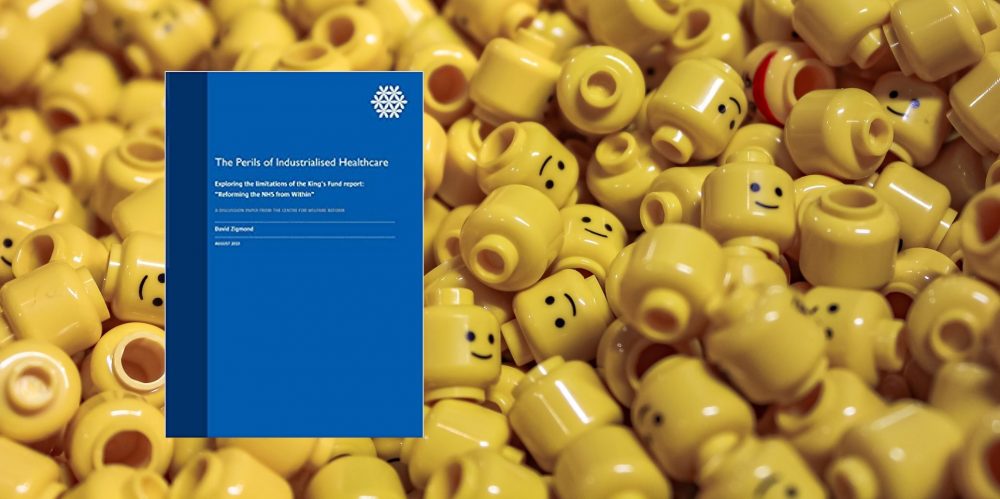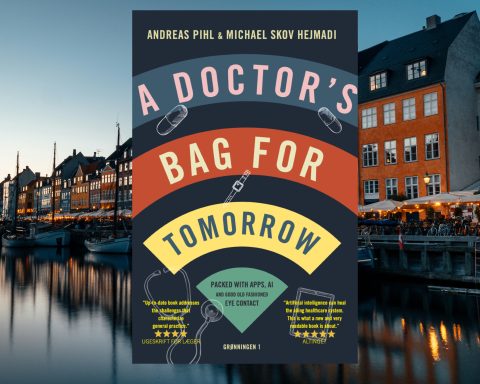 Peter Toon is a retired GP and GP academic. His research area is the philosophy and ethics of healthcare. His writing, both medical and non medical is available via his website – https://sites.google.com/site/peterdtoon/
Peter Toon is a retired GP and GP academic. His research area is the philosophy and ethics of healthcare. His writing, both medical and non medical is available via his website – https://sites.google.com/site/peterdtoon/
Is the NHS too Industrialised? In this report David Zigmond argues that it is,1 building on but going beyond a Kings Fund Report by Chris Ham from 20142 which criticised recent approaches to improving UK health care. Their arguments are important now as yet another round of NHS reforms are proposed.3
The King’s Fund Report concluded that large-scale structural reforms are a distraction and should be avoided. Few NHS professionals would disagree; at one time almost every NHS office seemed to display the quotation misattributed to Petronius Arbiter: “every time we were beginning to form up into teams we were reorganized… what a wonderful method for creating the illusion of progress while actually producing confusion, inefficiency, and demoralization.”
It also said that reform had relied too much on external stimuli; targets, performance management, inspection, regulation, competition and choice. These increase costs without significant benefits. “Transforming the NHS depends much less on bold strokes and big gestures by politicians than on engaging doctors, nurses and other staff in improvement programmes bringing about improvement ‘from within’.” Central to Zigmond’s argument is his distinction between curative treatment and pastoral healthcare.
Central to Zigmond’s argument is his distinction between curative treatment and pastoral healthcare. His curative treatment seems similar to what I have called the “bio-mechanical doctor”;4 analysing problems using medical science, curing them, and when that is impossible relieving symptoms using the same understanding.
He defines pastoral healthcare as “what health-carers can do when there are no rapidly curative treatments: when we cannot decisively ‘fix’… a problem of health or distress.” He thinks this applies to a large part of general practice, almost all mental health and to the care of stress-related, chronic, terminal and ageing conditions, which probably comprise the larger part of healthcare activity in general. This seems close to my call for making interpretive medicine,5 the art of helping people make sense of their illness and its place in their lives, central to healthcare.
…. the art of helping people make sense of their illness and its place in their lives.
Zigmond agrees with Ham that competitive tendering, and external controls and inspections, have done little to improve the NHS, but goes further to argue that these approaches, based on an outdated model of how to improve the efficiency and productivity of industry, actually damage healthcare.
He seems to have put his money where his mouth is, because in 2016 the CQC rapidly closed down his single handed practice for failure to comply with a range of organisational requirements.
The basic kindness and humanity needed to deliver both aspects of healthcare well.
Zigmond argues that external controls and inspections depress morale, and one does often hear professionals talk despondently of “box-ticking exercises”. They may prevent the very worse practice, but they cannot generate excellence; indeed they may even lower the average standard of practice by distorting priorities and creating a “culture of fear”.
Zigmond’s argument that management systems distract from patient-centred care is more questionable. Most of the faults the CQC found in his practice (failures in servicing equipment, DBS checks, call and recall systems, setting up a website) could have been sorted out by a competent practice manager with little clinical input. Appraisals and significant event reviews can be sterile box ticking exercises or can enhance professional flourishing and patient care; it depends on how they are approached.
Zigmond suggests an important issue missing from the King’s Fund Report is “Gigantism”, the scaling-up or merging of organisations in the interests of savings, logistical and management simplification, and pooling of expertise. This has been a steady trend for general practice over the last sixty years. Whilst sometimes this benefit for patients and professionals, it raises problems too. The larger a group the more relationships there are (it follows a geometrical progression) and since these take time to create and maintain larger organisations become more impersonal. There is less chance that a patient will see the same receptionist, nurse or doctor regularly and so develop a therapeutic relationship.
“Gigantism”… has been a steady trend for general practice … larger organisations become more impersonal.
Some of Zigmond’s anti-gigantism ideas sound frankly nostalgic; return to smaller medical schools, hospital firms, single handed practices. One cannot go back, and the reality of those structures was perhaps more mixed than he suggests: autonomous consultants were sometimes more autocratic tyrant than fatherly pastor, disappearing to Harley Street leaving bullied, exhausted and inexperienced Juniors to do the work. But that does not mean that we should not take seriously his call for structures which support continuity of personal, generalist care, in human scale institutions.
Zigmond criticises our reliance on IT, and it it true that desk-top computers can lead to record- centred rather than patient centred consultations; “he didn’t seem interested in me, just what was on the screen“ – but this happened with paper records too. Computers can enable clinician and patient to study the record together, producing partnership instead of paternalism. Similarly automated check ins can free receptionists to be welcoming rather than searching for names on lists, or enable them to hide behind their paperwork.
Desk-top computers can lead to record- centred rather than patient centred consultations.
How does the White Paper measure up against the principles put forward by Ham, Zigmond, and MacIntyre?
The CQC Report suggests they see institutions rather than practices as central.
Key themes taken up from the King’s Fund Report are integration, collaboration and prevention. The message that major structural reforms are unhelpful is acknowledged and these are explicitly rejected; however the creation of Statutory Integrated Care Systems, merging NHS England and NHS Improvement and creating “a duty to collaborate” sound very like structural reforms. I worry that this duty to collaborate will turn into another box ticking exercise, and I have argued before that framing responsibilities in terms of duties is unhelpful and just makes for one more burden for practitioners to carry. Perhaps unsurprisingly there is no discussion of how to develop the virtues of collaboration.
The White Paper makes much of building on the lessons of Covid, but as lawyers say, “hard cases make bad law”. So for example removal of the tedious bureaucratic competition requirements in buying services and materials seems highly desirable, but there also needs to be a way to avoid the sort of corruption alleged regarding PPE procurement and Track and Trace during the pandemic. Again, cultivating virtue rather than regulation might be more helpful.
Covid rightly led to a focus on the biomedical – Zigmond’s curative medicine – but the problems which will remain and grow after the acute phase of the pandemic are very different.
This context of an ageing population with multiple morbidity and the importance of mental health is acknowledged, but there is no discussion of how to support personal care and continuity. Zigmond rightly points out that this is central for the pastoral healthcare of these patients, but it is also important for good biomedical care. Patients with multiple problems and complex medication regimes and those with psychological problems take time to understand, and this is generally easier in small units or subunits where continuity is easier.
The focus still seems to be on managerial mechanisms rather than giving clinicians and other staff the freedom to engage in improvement from within.
A prominent theme is increased accountability, which seems largely to be seen in terms of accountability to elected politicians. New powers are proposed to allow the Secretary of State for Health and Social Care “to formally direct NHS England in relation to relevant functions”; “to direct NHS England to take on specific public health functions”; to “Intervene in local service reconfigurations”; and “to set standards in relation to hospital food”.
This is unsurprising. During the pandemics Ministers have necessarily become much more involved in the details of healthcare than usual – both in evaluating data to decide on lockdown measures going far beyond the health service and in directing and organising new resources to deal with a rapid rise in severely ill patients and roll out a major immunisation programme. Perhaps they have got a taste for being in charge and are not keen to relinquish this.
But as the King’s Fund Report pointed out that “policy and politics operate on different cycles, which results in short-term political initiatives getting in the way of the long-term policy commitments needed to deliver transformational change”. Giving greater power to someone with his eye on the next general election may not be the best way to achieve better accountability.
If this is to happen Ministers, civil servants and NHS managers must read Zigmond, Schumacher and MacIntyre as well as Ham and take all their messages to heart.
References
- Zigmond D, 2019. The Perils of Industrialised Healthcare. Pub: Centre for Welfare Reform, UK
- Ham C, 2014. Reforming the NHS from within – beyond hierarchy, inspection and markets publ King’s Fund London. https://www.kingsfund.org.uk/publications/reforming-nhs-within
- Dept of Health, 2021. Integration and innovation: working together to improve health and social care for all publ UK Government 11 February 2021. https://www.gov.uk/government/publications/working-together-to-improve-health-and-social-care-for-all
- Toon PD, 1994. What is Good General Practice? Occasional Paper no 65. Pub RCGP London.
- Toon PD, 2021. Towards an interpretive patient-centred practice. British Journal of General Practice 2021; 71 (707): 272-273. https://bjgp.org/content/71/707/272.full
- CQC, 2016. Dr David Zigmond Also known as St James Church Surgery. https://www.cqc.org.uk/location/1-495556335/reports
- Schumacher EF (1973) Small is Beautiful publ Blond & Briggs (and other editions).
- MacIntyre A, 2007. After Virtue 3rd Edition. Publ Duckworth, London.
- Toon PD, 2014. A Flourishing Practice? Publ RCGP London. https://library.oapen.org/handle/20.500.12657/45645
- Eliot TS (934) Choruses from the Rock in “ Complete Poems and Plays of TS Eliot” publ Faber & Faber 1969. https://www.poetrynook.com/poem/choruses-%C3%B4%C3%A7%C2%A3the-rock%C3%B4%C3%A7%C3%B8






